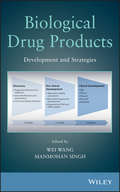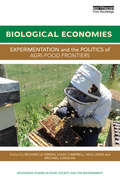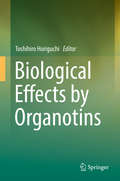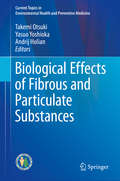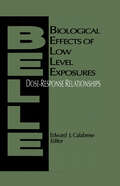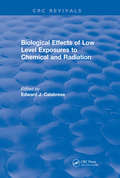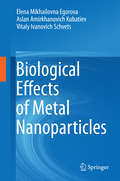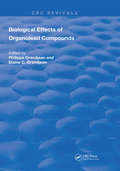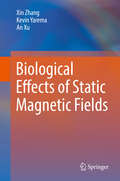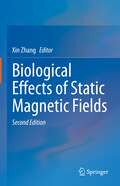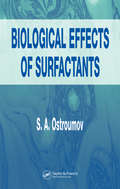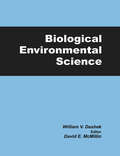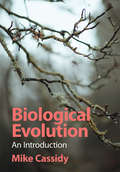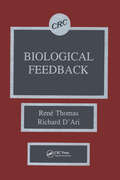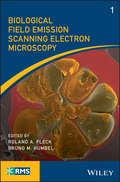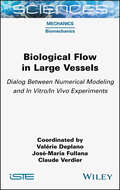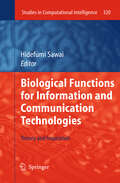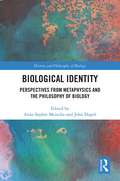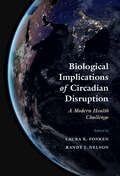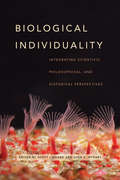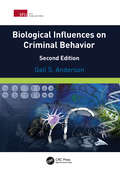- Table View
- List View
Biological Diversity: Balancing Interests Through Adaptive Collaborative Management
by John Schelhas Eva Wollenberg Louise E. Buck Charles C. GeislerWe live in a world of wide pendulum swings regarding management policies for protected areas, particularly as they affect the involvement of local people in management. Such swings can be polarizing and halt on-the-ground progress. There is a need to find ways to protect biodiversity while creating common ground and building management capacity thr
Biological Drug Products: Development and Strategies
by Manmohan Singh Wei WangTested and proven solutions to the challenges of biological drug product development Biological drug products play a central role in combating human diseases; however, developing new successful biological drugs presents many challenges, including labor intensive production processes, tighter regulatory controls, and increased market competition. This book reviews the current state of the science, offering readers a single resource that sets forth the fundamentals as well as tested and proven development strategies for biological drugs. Moreover, the book prepares readers for the challenges that typically arise during drug development, offering straightforward solutions to improve their ability to pass through all the regulatory hurdles and deliver new drug products to the market. Biological Drug Products begins with general considerations for the development of any biological drug product and then explores the strategies and challenges involved in the development of specific types of biologics. Divided into five parts, the book examines: Part 1: General Aspects Part 2: Proteins and Peptides Part 3: Vaccines Part 4: Novel Biologics Part 5: Product Administration/Delivery Each chapter has been prepared by one or more leading experts in biological drug development. Contributions are based on a comprehensive review and analysis of the current literature as well as the authors' first-hand experience developing and testing new drugs. References at the end of each chapter serve as a gateway to original research papers and reviews in the field. By incorporating lessons learned and future directions for research, Biological Drug Products enables pharmaceutical scientists and students to improve their success rate in developing new biologics to treat a broad range of human diseases.
Biological Economies: Experimentation and the politics of agri-food frontiers (Routledge Studies in Food, Society and the Environment)
by Michael Carolan Hugh Campbell Nick Lewis Richard Le HeronRecent agri-food studies, including commodity systems, the political economy of agriculture, regional development, and wider examinations of the rural dimension in economic geography and rural sociology have been confronted by three challenges. These can be summarized as: ‘more than human’ approaches to economic life; a ‘post-structural political economy’ of food and agriculture; and calls for more ‘enactive’, performative research approaches. This volume describes the genealogy of such approaches, drawing on the reflective insights of more than five years of international engagement and research. It demonstrates the kinds of new work being generated under these approaches and provides a means for exploring how they should be all understood as part of the same broader need to review theory and methods in the study of food, agriculture, rural development and economic geography. This radical collective approach is elaborated as the Biological Economies approach. The authors break out from traditional categories of analysis, reconceptualising materialities, and reframing economic assemblages as biological economies, based on the notion of all research being enactive or performative.
Biological Effectors of Social Determinants of Health in Cancer: Identification and Mitigation: Proceedings of a Workshop
by Board on Health Care Services National Cancer Policy Forum National Academies of Sciences, Engineering, and Medicine Health and Medicine DivisionSocial determinants of health, including factors such as the conditions in which people are born, grow, work, live, and age; their education and income; and many other elements can influence their likelihood of developing cancer, the type of cancer, the cancer stage at diagnosis, the quality of care they receive, and their health outcomes. The National Cancer Policy Forum hosted a workshop in March 2024 to examine the complex interactions among biological variables and these factors and their impact on cancer-related health outcomes and health equity.
Biological Effects by Organotins
by Toshihiro HoriguchiThis book provides an overview of the induction mechanism of imposex caused by organotin compounds in gastropods, as well as fundamental information on the physiology and biochemistry of reproduction in mollusks. Are the sex hormones of gastropod mollusks vertebrate-type steroids, or neuropeptides? What about lipid disturbance and membrane toxicity due to organotin compounds? The book also discusses the latest findings on the role of nuclear receptors, such as retinoid X receptor (RXR), retinoic acid receptor (RAR) and peroxisome proliferator-activated receptor (PPAR), in the development of imposex in gastropods. Further, it describes the current state of contamination by organotins in the marine environment and gastropod imposex, especially focusing on Europe and Asia, introduces readers to analytical techniques for organotin compounds, and assesses the contamination and adverse effects of alternatives to organotin-based antifouling paints. Imposex, a superimposition of male genital tracts, such as penis and vas deferens, on female gastropod mollusks, is known as a typical phenomenon or consequence of endocrine disruption in wildlife. Imposex is typically induced by very low concentrations of organotin compounds, such as tributyltin (TBT) and triphenyltin (TPhT) from antifouling paints on ships and fishing nets. Reproductive failure may be brought about in severely affected stages of imposex, resulting in population decline and/or mass extinction. Thus, gastropod imposex has been recognized as a critical environmental pollution issue. Although gastropod imposex is also highly interesting for the biological sciences because of its acquired pseudohermaphroditism and/or sex change by certain chemicals, such as TBT and TPhT, the mechanism that induces the development of imposex remains unclear, possibly due to our limited understanding of the endocrinology of gastropod mollusks. This book offers a useful guide for professionals and students interested in the fields of aquatic biology, invertebrate physiology, ecotoxicology and environmental science.
Biological Effects of Fibrous and Particulate Substances (Current Topics in Environmental Health and Preventive Medicine #0)
by Takemi Otsuki Yasuo Yoshioka Andrij HolianThis volume examines our current understanding of the biological effects of fibrous and particulate substances, including discussions on nanoparticles. It offers comprehensive information on the latest insights into the immunological effects of various irritants on the human body. Readers will benefit from the contributing authors' diverse perspectives and extensive discussions of key issues, which include molecular alterations of the immune system and autoimmune diseases in connection with asbestos and silica, among others. The chapters also discuss recommendations, practical methods, and nanosafety science in situations involving exposure to nanotoxic substances. Edited in collaboration with the Japanese Society for Hygiene, this book provides up-to-date information on the immunological effects of nanotoxic substances to researchers interested in environmental and occupational health. Presenting a number of recent concepts and findings in the field, it enables readers to gain a comprehensive knowledge of health problems caused by environmental fibrous and particulate substances.
Biological Effects of Low Level Exposures Dose-Response Relationships
by Edward J. CalabreseBiological Effects of Low-Level Exposures, more commonly referred to as BELLE, began as a conference in May 1990. Its members are committed to the enhanced understanding of low-dose responses of all types to human exposures to chemical and physical agents, whether of an expected or paradoxical nature.The focus of BELLE encompasses dose-response relationships to toxic agents, pharmaceuticals, and natural products over wide dosage ranges in both in vitro systems and in vivo systems, including human populations. While BELLE promotes the scientific understanding of low-level effects, its primary goal is the scientific evaluation of existing literature and ways to improve research and assessment methods.
Biological Effects of Low Level Exposures to Chemical and Radiation (CRC Press Revivals)
by Edward J. CalabreseThis book features papers presented at a workshop discussing current knowledge about the biological effects of low level exposures (BELLE). The book is designed to help establish a scientific base for future BELLE initiatives and is focused on the issue of the toxicological implications of biological adaptations. Hormesis is considered in a broad, conceptual manner, as well as at molecular and biochemical levels. Other topics covered include the effects of low levels of radiation on biological systems, how the liver adapts to genetic insults, biostatistical considerations when designing studies that address issues associated with biological responses to low doses of chemicals and radiation, and the issues that surround the interpretation of findings from such studies.
Biological Effects of Metal Nanoparticles
by Elena Mikhailovna Egorova Aslan Amirkhanovich Kubatiev Vitaly Ivanovich SchvetsThisbook offers a comprehensive overview of recent studies conducted on thebiological effects of metal nanoparticles. It also provides a solid theoreticalfoundation and various metal nanoparticle synthesis methods. PartI reviews the main chemical methods used for synthesizing metal nanoparticlesin a solution and describes original method of biochemical synthesis, as wellas some special procedures developed specifically for studying the biologicalactivity of nanoparticles. PartII analyzes current literature on the effects of metal nanoparticles observedin microorganisms and addresses the influence of silver nanoparticles obtainedby biochemical synthesis on biological objects on various organization levels,namely on microorganisms, acellular slimmold, unicellular alga, plant seeds andmammalian cells. Thelast section explains the central problems common in studies on the biologicaleffects of metal nanoparticles and outlines potential uses of this trend inbio-nanotechnologies. Thisbook is aimed at specialists, professors and students aspiring to expand theirknowledge about the biological activities of metal nanoparticles andnanoparticle-containing materials.
Biological Effects of Organolead Compounds (Routledge Revivals)
by M. A. Philippe Grandjean M. D. Ph. D. And Elaine C. Grand GrandjeanFirst published in 1984: This book is a compilation of research on Organolead Compounds.
Biological Effects of Static Magnetic Fields
by Xin Zhang Kevin Yarema An XuThe book summarize the emerging topic about the effects of SMF on biological samples ranging from single molecules, subcellular compartments, and cells to whole organisms, as well as the potential application of SMF in clinical treatment of cancer and other diseases. With the development and growing popularity of modern appliances, including MRI in the hospitals, the potential impact of magnetic fields on human health is invoking increasing concerns. At the same time, static magnetic field (SMF) has been used in the clinical treatment of tumors and other diseases for decades. However, there are still some reservations and uncertainties about these treatments, which are largely due to the differential biological effects reported in the literature. These experimental inconsistencies are mainly caused by variations such as different magnetic field types, intensities, treatment time as well as biological samples examined. This volume will help clarify some dilemmas in this field and encourage further investigation in order to achieve a better understanding of the biological effects of SMF, aiming for a rational application of SMF in clinical therapy in the near future. The book is useful for scientists and students in static magnetic field and clinical doctors et cl.
Biological Effects of Static Magnetic Fields
by Xin ZhangThe book summarizes the emerging topic about the effects of SMF on biological samples ranging from single molecules, subcellular compartments, and cells to whole organisms. It also discusses the potential application of SMF in clinical treatment of cancer, pain, diabetes and other diseases.With the development and growing popularity of modern appliances like MRI in hospitals, the potential impact of magnetic fields on human health is invoking increasing concerns. At the same time, SMF has been explored in the treatment of tumor and other diseases for decades. Nevertheless, there are still some reservations and uncertainties about these treatments, which are largely due to the differential biological effects reported in the literature. These experimental inconsistencies are mainly caused by variations such as different magnetic field types, intensities, treatment time, as well as biological samples examined. The second edition added eight new chapters about new progress in this field including impacts of SMFs, magnetism of biomolecules, and potential of SMFs in the management of bone, pain, diabetes, and immune systems. This volume will help clarify some dilemmas in this field and encourage further investigations in order to achieve a better understanding of the biological effects of SMF, aiming for a rational application of SMF in clinical therapy in the near future. The book is useful for scientists, doctors, and students who are interested in magnetic fields and life sciences
Biological Effects of Surfactants
by S.A. OstroumovOffering a new perspective on the hazards of pollution, Biological Effects of Surfactants examines the effects of anionic, non-ionic, cationic surfactants, and detergents on a wide range of organisms, populations, communities, and ecosystems. The author establishes new quantitative characteristics of the effects and presents study results on newly discovered phenomena. While proposing and substantiating new priorities and approaches for testing, assessing, and characterizing the biological activities and hazards of substances, the book illustrates how the data obtained can be used to develop effective environmental remediation and protection measures to improve water quality.
Biological Environmental Science
by William V DashekBiological Environmental Science is an introductory textbook for undergraduate students who desire a one semester course or, alternatively, a springboard course for advanced environmental offerings. This book features timely issues such as global warming, air, ground and water pollutions, population growth, species extinction and environmental policy. Unique features of this book include the use of research data and literature, copious illustrations and appendices for the scientific method.
Biological Evidence
by Ann Bucholtz Jon Lewis"The text is an introduction to the types of biological evidence commonly found at crime scenes and how to collect it for non-science majors and for professionals working in the criminal justice system. Specific biological evidence discussed includes blood, semen, saliva, urine, feces, hair, and fingernails. Additional topics include autopsy, the basic departments of the crime laboratory, toxicology, forensic entomology, and uncollectible biological evidence. Packaging, preservation, and care of biological evidence is discussed and chain of custody is explained. Additional topics include DNA, case studies, courtroom testimony, and exhibits for the courtroom.
Biological Evolution: An Introduction
by Mike CassidyBiological evolution, the theory of natural selection and of common descent, is a triumph both of human reasoning and scientific undertaking. The biological discipline of evolution contains both a chronicle of human endeavour and the story of life on Earth. This book is concerned with living forms and how they developed from 'simple and unpromising beginnings'. It considers evolution as both process and product. The author, an experienced teacher and educator, employs a historical narrative, used to convey the idea of 'change with modification' and to emphasise the relevance of evolution to contemporary bioscience. Biological evolution has now become part of the scientific orthodoxy and this accessible text will assist undergraduate students in the biological sciences within any ongoing debate.
Biological Extinction: New Perspectives
by Partha Dasgupta Peter H. Raven Anna L. McIvorThe rapidly increasing human pressure on the biosphere is pushing biodiversity into the sixth mass extinction event in the history of life on Earth. The organisms being exterminated are integral working parts of our planet's life support system, and their loss is permanent. Like climate change, this irreversible loss has potentially devastating consequences for humanity. As we come to recognise the many ways in which we depend on nature, this can pave the way for a new ethic that acknowledges the importance of co-existence between humans and other species. Biological Extinction features chapters contributed by leading thinkers in diverse fields of knowledge and practice, including biology, economics, geology, archaeology, demography, architecture and intermediate technology. Drawing on examples from various socio-ecological systems, the book offers new perspectives on the urgent issue of biological extinction, proposing novel solutions to the problems that we face.
Biological Feedback
by Rene Thomas Richard D'AriClearly explaining the logical analysis of biological control phenomena, Biological Feedback answers questions concerning everything from regulation to logic. This rare monograph presents a formal methodology for analyzing the dynamic behavior of complex systems. The easy-to-read text describes a simple logical formalization called "kinetic logic". The reader discovers how this method is used to predict all possible patterns of behavior of which a system is capable. It includes specific conditions required for each pattern. It also explains how to modify an incorrect model in order to account for the observed behavior. The authors give special attention to the two basic types of simple feedback loops: positive and negative. This volume is filled with easy-to-use tables, providing quick reference throughout the book. The subject matter is of great interest to everyone working in molecular genetics and developmental biology. Researchers, immunologists, physical chemists, physicists, electrical engineers, economists, and mathematicians will find this unique text to be an informative, indispensable resource.
Biological Field Emission Scanning Electron Microscopy (RMS - Royal Microscopical Society)
by Roland A. Fleck Bruno M. HumbelThe go‐to resource for microscopists on biological applications of field emission gun scanning electron microscopy (FEGSEM) The evolution of scanning electron microscopy technologies and capability over the past few years has revolutionized the biological imaging capabilities of the microscope—giving it the capability to examine surface structures of cellular membranes to reveal the organization of individual proteins across a membrane bilayer and the arrangement of cell cytoskeleton at a nm scale. Most notable are their improvements for field emission scanning electron microscopy (FEGSEM), which when combined with cryo-preparation techniques, has provided insight into a wide range of biological questions including the functionality of bacteria and viruses. This full-colour, must-have book for microscopists traces the development of the biological field emission scanning electron microscopy (FEGSEM) and highlights its current value in biological research as well as its future worth. Biological Field Emission Scanning Electron Microscopy highlights the present capability of the technique and informs the wider biological science community of its application in basic biological research. Starting with the theory and history of FEGSEM, the book offers chapters covering: operation (strengths and weakness, sample selection, handling, limitations, and preparation); Commercial developments and principals from the major FEGSEM manufacturers (Thermo Scientific, JEOL, HITACHI, ZEISS, Tescan); technical developments essential to bioFEGSEM; cryobio FEGSEM; cryo-FIB; FEGSEM digital-tomography; array tomography; public health research; mammalian cells and tissues; digital challenges (image collection, storage, and automated data analysis); and more. Examines the creation of the biological field emission gun scanning electron microscopy (FEGSEM) and discusses its benefits to the biological research community and future value Provides insight into the design and development philosophy behind current instrument manufacturers Covers sample handling, applications, and key supporting techniques Focuses on the biological applications of field emission gun scanning electron microscopy (FEGSEM), covering both plant and animal research Presented in full colour An important part of the Wiley-Royal Microscopical Series, Biological Field Emission Scanning Electron Microscopy is an ideal general resource for experienced academic and industrial users of electron microscopy—specifically, those with a need to understand the application, limitations, and strengths of FEGSEM.
Biological Flow in Large Vessels: Dialog Between Numerical Modeling and In Vitro/In Vivo Experiments
by Valerie Deplano Jose-Maria Fullana Claude VerdierThis book examines recent methods used for blood flow modeling and associated in vivo experiments, conducted using experimental data from medical imaging. Different strategies are proposed, from smallscale models to complex 3D modeling using modern computational codes. The geometries are wide-ranging and deal with the narrowing and widening of sections (stenoses, aneurysms), bifurcations, geometries associated with prosthetic elements, and even cases of vessels with smaller dimensions than those of the blood cells circulating in them.Biological Flow in Large Vessels provides answers to the question of how medical and biomechanical knowledge can be combined to address clinical problems. It offers guidance for further development of numerical models, as well as experimental protocols applied to clinical research, with tools that can be used in real-time and at the patient’s bedside, for decision-making support, predicting the progression of pathologies, and planning personalized interventions.
Biological Functions for Information and Communication Technologies: Theory and Inspiration (Studies in Computational Intelligence #320)
by Hidefumi SawaiBy incorporating biologically-inspired functions into ICT, various types of new-generation information and communication systems can be created. Just some example of areas already benefiting from such design inspiration are network architectures, information processing, molecular communication, and complex network modeling for solving real world-problems. This book provides the theoretical basis for understanding these developments and explains their practical applications. Highlighted inserts appears throughout to help readers to understand the very latest topics in these emerging research fields. The book ends with a more philosophical discussion on how new ICT solutions can be found by looking at analogous systems in biology. This new way of thinking may help researchers and practitioners to apply innovative ideas in developing next-generation technologies.
Biological Identity: Perspectives from Metaphysics and the Philosophy of Biology (History and Philosophy of Biology)
by Anne Sophie MeinckeAnalytic metaphysics has recently discovered biology as a means of grounding metaphysical theories. This has resulted in long-standing metaphysical puzzles, such as the problems of personal identity and material constitution, being increasingly addressed by appeal to a biological understanding of identity. This development within metaphysics is in significant tension with the growing tendency amongst philosophers of biology to regard biological identity as a deep puzzle in its own right, especially following recent advances in our understanding of symbiosis, the evolution of multi-cellular organisms and the inherently dynamical character of living systems. Moreover, and building on these biological insights, the broadly substance ontological framework of metaphysical theories of biological identity appears problematic to a growing number of philosophers of biology who invoke process ontology instead. This volume addresses this tension, exploring to what extent it can be dissolved. For this purpose, the volume presents the first selection of essays exclusively focused on biological identity and written by experts in metaphysics, the philosophy of biology and biology. The resulting cross-disciplinary dialogue paves the way for a convincing account of biological identity that is both metaphysically constructive and scientifically informed, and will be of interest to metaphysicians, philosophers of biology and theoretical biologists.
Biological Individuality: Integrating Scientific, Philosophical, and Historical Perspectives
by Lynn K. Nyhart Scott Lidgard and Lynn K. NyhartIndividuals are things that everybody knows—or thinks they do. Yet even scholars who practice or analyze the biological sciences often cannot agree on what an individual is and why. One reason for this disagreement is that the many important biological individuality concepts serve very different purposes—defining, classifying, or explaining living structure, function, interaction, persistence, or evolution. Indeed, as the contributors to Biological Individuality reveal, nature is too messy for simple definitions of this concept, organisms too quirky in the diverse ways they reproduce, function, and interact, and human ideas about individuality too fraught with philosophical and historical meaning. Bringing together biologists, historians, and philosophers, this book provides a multifaceted exploration of biological individuality that identifies leading and less familiar perceptions of individuality both past and present, what they are good for, and in what contexts. Biological practice and theory recognize individuals at myriad levels of organization, from genes to organisms to symbiotic systems. We depend on these notions of individuality to address theoretical questions about multilevel natural selection and Darwinian fitness; to illuminate empirical questions about development, function, and ecology; to ground philosophical questions about the nature of organisms and causation; and to probe historical and cultural circumstances that resonate with parallel questions about the nature of society. Charting an interdisciplinary research agenda that broadens the frameworks in which biological individuality is discussed, this book makes clear that in the realm of the individual, there is not and should not be a direct path from biological paradigms based on model organisms through to philosophical generalization and historical reification.
Biological Influences on Criminal Behavior
by Gail AndersonBiological Influences on Criminal Behavior, Second Edition is fully updated to include recent research, studies, and publications examining the integration of the biological view with mainstream social, psychological, and environmental views in influences in criminality and criminal behavior. The first edition of the book was written with the belief, grounded in research, that something vital can be discovered when we assess all the factors related to the causes of crime, including biology. Since the first edition published, it has become broadly accepted that biology is certainly a factor in criminal behavior, albeit a singular piece to the puzzle. Increased collaborations between scientists and criminologists has led to a much stronger understanding of the intricacies of biology’s role in behavior. As well, more criminologists have biological backgrounds. As the science involved became more complex, so too did this text. This second edition considers the more recent and integrated research that is being conducted today to show the interaction between the environment and a person’s biology that lead to our behavior. It has even been shown that the environment acts on, and actually changes the functions, of some genes. The book begins with basic scientific principles and advances to introduce the reader to the more in-depth discussions of various biological influencers. Biological Influences on Criminal Behavior, Second Edition is written primarily for social science and law students who wish to understand this exciting area. The book offers a greater understanding of this rapidly growing field so that its lessons can help to inform policy, treatments, rehabilitation and the law.

